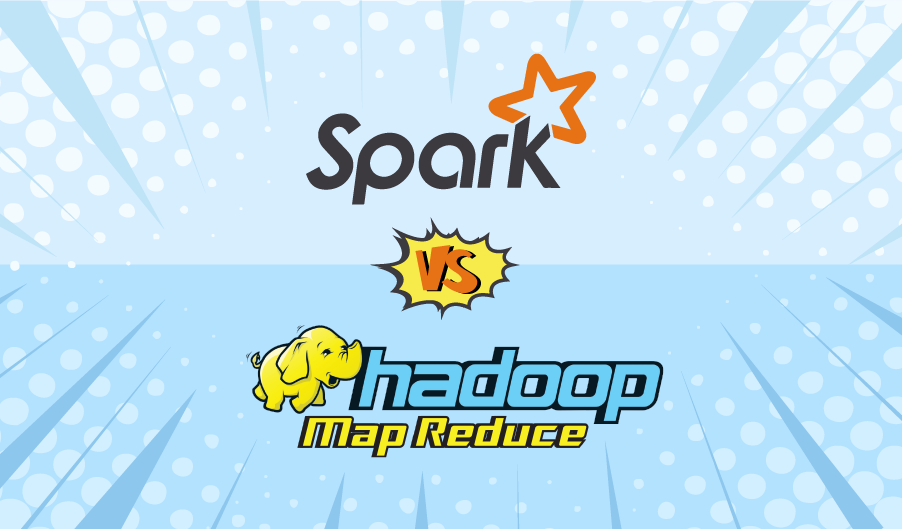Introduction
Businesses are increasingly dealing with huge volumes of data that demand efficient processing and analysis in today’s data-driven environment. Big data frameworks such as Spark and Hadoop MapReduce have developed as powerful solutions for addressing this difficulty.
However, in order to select the best framework for your organization’s specific demands, you must first grasp their distinctions and capabilities. In this post, we compare Spark with Hadoop MapReduce, examining their capabilities, application cases, and important differentiators. Whether you want quicker processing speeds, real-time analytics, or interactive data exploration, this thorough guide will help you through the decision-making process and choose the best framework for your big data projects.
When it comes to choosing between Spark and Hadoop MapReduce as big data frameworks, several factors should be considered. While both frameworks are designed to process large-scale data, they have distinct features and use cases. Let’s explore the key differences between Spark and Hadoop MapReduce to help you make an informed decision.

Spark V/S Hadoop MapReduce
- Processing Speed: Because of its in-memory processing capabilities, Spark is generally faster than Hadoop MapReduce. Spark has the ability to cache data in memory, allowing for iterative and interactive processing, which is very useful for machine learning algorithms and real-time analytics. Hadoop MapReduce, on the other hand, writes intermediate results to disk after each stage, resulting in slower performance.
- Ease of Use: When compared to Hadoop MapReduce, Spark delivers a more user-friendly and expressive API. It provides APIs in a variety of languages, including Scala, Java, Python, and R, making it easier for developers of varying skill levels to work with the framework. Hadoop MapReduce, on the other hand, is mostly written in Java, which can be difficult for developers who are unfamiliar with the language.
- Fault Tolerance: Because Hadoop MapReduce breaks jobs into smaller sub-tasks and distributes them across a cluster of nodes, it offers built-in fault tolerance features. If one of the nodes fails, the task is automatically reallocated to another. Spark offers fault tolerance as well, but it does it using Resilient Distributed Datasets (RDDs) and the Directed Acyclic Graph (DAG) execution paradigm.
- Data Processing Paradigm: Hadoop MapReduce employs a batch processing paradigm, in which data is processed in batches after it has been saved to disk. It is ideal for processing massive amounts of data, but it can be slow for iterative or interactive tasks. Spark, on the other hand, provides batch processing, interactive queries, streaming, and machine learning, making it more adaptable to a wide range of applications.
- Hadoop MapReduce has a robust ecosystem with different tools and technologies built around it, including Apache Hive, Apache Pig, and Apache Sqoop. It works well in conjunction with Hadoop Distributed File System (HDFS) and other Hadoop components. Spark has a growing ecosystem and can be integrated with Hadoop, although it can also operate independently of Hadoop.
In conclusion, consider Spark if you require quicker processing, real-time analytics, and support for multiple data processing paradigms. Spark’s ease of use and expanding ecosystem are also benefits. Hadoop MapReduce, on the other hand, may be a viable solution if you primarily require batch processing, have a mature Hadoop ecosystem in place, or want a simpler programming approach.
Keep in mind that the optimal option is determined by your individual use case, requirements, and current infrastructure. Before making a decision, consider your data processing requirements, team expertise, and long-term ambitions.
What are the applications of Hadoop MapReduce?

Hadoop MapReduce is well-suited for a variety of activities and use cases, including batch processing and large-scale data analysis. Here are some frequent jobs for which Hadoop MapReduce is used:
- Data Extraction and Transformation: Hadoop MapReduce can process and transform vast amounts of raw data into a structured format in an effective manner. It is frequently used for data cleansing, filtering, and formatting.
- Batch Processing: Hadoop MapReduce is intended for parallel processing of big data volumes. It has the ability to spread jobs across a cluster of machines, making it suited for batch processing activities such as log analysis, data aggregation, and batch ETL (Extract, Transform, Load).
- Hadoop MapReduce can be used to create data warehouses or data lakes. It allows for the storage and retrieval of organized and semi-structured data, which makes it valuable for analytics and reporting.
- Text and Document Processing: Hadoop MapReduce is often used for processing massive amounts of text data, such as document analysis, information extraction, text mining, and search algorithm implementation.
- Log Analysis: Hadoop MapReduce is capable of analyzing and processing logs from a variety of sources, including web servers, application servers, and network devices. It can assist in extracting insights, identifying trends, and detecting anomalies in log data.
- Recommendation Systems: By processing massive data sets and conducting calculations based on user preferences, item attributes, and historical data, Hadoop MapReduce may be utilized to develop recommendation systems.
- Machine Learning: While Hadoop MapReduce was not developed primarily for machine learning, it can be utilized for specific machine learning applications, especially when paired with libraries such as Apache Mahout or Apache Spark MLlib. It is frequently used in machine learning pipelines for preprocessing and feature extraction.
- Data Analysis and Aggregation: Hadoop MapReduce is well-suited to complicated data analysis and aggregation activities like producing statistical summaries, calculating averages, performing joins, and grouping data based on particular criteria.
It should be noted that, while Hadoop MapReduce is excellent for these jobs, it may not be the best solution for real-time or interactive processing. Frameworks such as Apache Spark or Apache Flink are frequently preferred for these use cases.
Tasks Spark is good for?

Spark is a robust big data framework that provides numerous benefits for a variety of data processing workloads. Here are some examples of jobs that Spark is well-suited for:
- Batch Processing: Spark excels at large-scale batch processing tasks. It can process enormous volumes of data in parallel over a cluster of machines, making it suited for data preparation, ETL (Extract, Transform, Load), and data integration jobs.
- Real-time Stream Processing: A Spark component, Spark Streaming, offers real-time stream processing and analytics. It can process data streams from a variety of sources, including log files, social media feeds, and IoT devices, enabling real-time processing, event detection, and data aggregation.
- Interactive Analytics: Spark includes an interactive shell known as Spark Shell that allows users to undertake exploratory data analysis and run interactive queries. On huge datasets, it offers interactive data exploration, iterative data analysis, and ad hoc querying.
- Machine Learning: The MLlib package in Spark includes a diverse set of machine learning techniques and tools. It enables data scientists and analysts to rapidly design and train machine learning models. The distributed computing features of Spark allow for faster model training, parameter adjustment, and model evaluation.
- Graph Processing: Spark GraphX is a Spark-based graph processing framework. It provides a simple API for graph calculations and graph-structured data analysis. It can be used for tasks like social network analysis, recommendation systems, and fraud detection.
- Data Streaming and Complex Event Processing: Spark’s Structured Streaming API supports continuous data streams, enabling complex event processing, real-time analytics, and near-real-time decision-making based on streaming data.
- Data Exploration and Visualization: Spark can help with data exploration and visualization. Spark can assist analyze and visualize massive datasets to gain insights and effectively communicate discoveries by leveraging libraries like Apache Zeppelin or integrating with visualization tools like Tableau.
- Distributed SQL Processing: Spark SQL enables you to query structured data using SQL-like syntax while taking advantage of the power of distributed computing. It interfaces with major SQL-based tools and performs SQL queries on massive datasets efficiently.
Overall, Spark’s ability to perform batch processing, real-time stream processing, interactive analytics, machine learning, graph processing, and other activities makes it an excellent candidate for a variety of big data jobs. It provides performance, scalability, and a consistent framework for various data processing paradigms.

Practical applications where Spark has proven to be better than MapReduce
Spark has outperformed MapReduce in a variety of practical applications due to its speed, flexibility, and sophisticated capabilities. Here are some examples of where Spark outperforms MapReduce:
- Iterative Machine Learning: The in-memory processing capabilities of Spark make it ideal for iterative machine learning methods. Training and assessing machine learning models can need numerous rounds, and Spark’s ability to cache data in memory between iterations considerably accelerates the process when compared to MapReduce, which writes intermediate results to disk.
- Real-time Analytics: Because Spark can handle real-time streaming data, it is perfect for real-time analytics applications. Processing real-time social media feeds, analyzing log data in real-time for anomaly detection, or detecting fraud in real-time can all be done more successfully using Spark Streaming or Structured Streaming than with MapReduce.
- Interactive Data Analysis: The interactive shell and in-memory processing of Spark enable interactive data analysis, allowing users to interactively explore and query massive datasets. This is especially useful for data exploration, ad hoc querying, and interactive analytics applications where users require quick response times and the opportunity to repeatedly improve their queries.
- Graph Processing: Spark GraphX, a Spark-based graph processing library, provides efficient graph calculation capabilities. GraphX allows you to perform tasks like social network analysis, recommendation systems, and graph-based algorithms. For graph processing applications, its ability to store graph data in memory and execute parallel calculations on large-scale graphs provides considerable performance advantages over MapReduce.
- Data Pipelines and sophisticated processes: Spark’s unified design makes it simple to create sophisticated data pipelines and processes. Its extensive API set and interoperability with a wide range of data sources, including Hadoop Distributed File System (HDFS), Apache Hive, and Apache Kafka, make it easier to integrate disparate components and perform data transformations, aggregations, and computations in a single pipeline. With its emphasis on batch processing, MapReduce is less suited to such complex workflows.
- Interactive Data Visualization: Spark’s interaction with visualization tools such as Apache Zeppelin, as well as support for libraries such as Apache Spark SQL and Spark DataFrame API, allow users to interactively analyze and view huge datasets. The capacity of Spark to process and analyze data quickly, along with visualization capabilities, improves the exploratory data analysis process and allows users to acquire insights more quickly than with MapReduce.
These examples demonstrate how Spark’s features, including as in-memory processing, real-time streaming, interactive analysis, graph processing, and data pipeline flexibility, have brought considerable advantages over MapReduce in practical applications.
Which framework to choose – Spark or Hadoop MapReduce ?
The decision between Spark and Hadoop MapReduce as the preferred big data framework is influenced by a number of factors. Here is a thorough conclusion to help you make a decision:
- Processing Speed: Spark is the better choice if you need speedier processing, real-time analytics, and support for iterative algorithms. Spark’s in-memory processing capabilities outperform MapReduce’s disk-based processing significantly.
- Data Processing Paradigm: If your use cases largely involve batch processing and basic data transformations, Hadoop MapReduce may be a good fit. Spark, on the other hand, provides a unified solution for batch processing, real-time streaming, interactive analytics, machine learning, and graph processing.
- Ease of Use: Spark has a more user-friendly and expressive API, supporting numerous programming languages and making it accessible to developers of various skill levels. Hadoop MapReduce is mostly written in Java, which can make it more difficult for those who are unfamiliar with the language.
- Fault Tolerance: While both frameworks provide fault tolerance, they do so through different techniques. Hadoop MapReduce breaks workloads down into smaller sub-tasks and distributes them across a cluster, whereas Spark offers fault tolerance using Resilient Distributed Datasets (RDDs) and the Directed Acyclic Graph (DAG) execution architecture.
- Hadoop MapReduce has a robust ecosystem with many tools built around it, allowing it to be well-integrated with Hadoop components. Spark has a growing ecosystem and can be integrated with Hadoop, although it can also operate independently of Hadoop.
In conclusion, utilize Spark if you value speed, real-time processing, adaptability, and ease of usage. It excels at iterative machine learning, real-time analytics, interactive analysis, graph processing, and sophisticated processes.
If your use cases largely include batch processing and simple data transformations, and you already have a mature Hadoop ecosystem in place, choose Hadoop MapReduce.
Finally, the ideal option is determined by your individual needs, existing infrastructure, team expertise, and long-term ambitions. Before making a decision, evaluate your data processing requirements and consider criteria like as processing speed, flexibility, simplicity of use, fault tolerance, and ecosystem integration.



